Over the past eleven months, Ukraine’s people have suffered far too much killing and destruction. Most but by no means all of that devastation has been at the hands of the Russian military. (Residents of the country’s eastern provinces have been hammered hard by the Ukrainian military, over the course of several years now. Their fate has been almost ignored in Western media.)
How do we think about and respond to this suffering? Should we join the serried ranks of the Western punditocracy who endlessly urge that ever more and deadlier weaponry be sent to Ukraine? Or shouldn’t we, instead, be starting to call for a formalized, country-wide ceasefire in Ukraine… That is, an Armistice like the one that for 70 years now has preserved a broad ceasefire on the Korean peninsula and has allowed South Korea not just to survive but also to flourish.
(I realize the Koreas have not been totally peaceful since their Armistice went into force in 1953. North Korea has a belligerent, nuclear-armed leader who often seems very erratic. And South Korea’s president is now also talking about the possibility of going nuclear. But still, the Armistice has served all of Korea’s people—especially those in the South—and the cause of world peace, pretty well for many decades.)
The photo above shows the final signing of the Korean Armistice Agreement, in July 1953, in the North Korean village of Panmunjon. I’ll come back to the Koreas later. But for now, let’s circle back to the grinding—and globally very harmful—situation in Ukraine.
Ever since Russia launched its large-scale invasion of Ukraine last February, political leaders and influential commentators in NATO countries have called for tipping the balance against Russia by supplying Kyiv with ever larger shipments of ever more capable weaponry, and increased training. Since the beginning, though, the NATO leaders have also carefully avoided crossing the line to any direct engagement there between NATO and Russia. Hence, no NATO weapons have been sent that would allow Ukraine to strike easily into Russia. And there has been no direct involvement by NATO militaries in the fighting there.
Those lines have sometimes been blurred, or stretched. (HIMARS, in limited numbers. Fighting vehicles. Lots of remote help from outside, with recon… ) But the basic mantra of no direct NATO involvement has been kept in place. And very wisely so. Ukraine is not a NATO member. NATO’s mutual defense agreements do not apply to it. Any direct fighting between a nuclear-armed NATO and a nuclear-armed Russia could all too easily escalate to the terrifying level where no-one wants to go.
But the provision of continuing military aid to Ukraine and the limits on that aid have, between them, kept Ukrainians trapped in a meat-grinder of continuing warfare that, at the level of facts on the ground, has shifted very little over recent months. Ever since the Russians got pushed out of the northern areas around Kiev, the front-lines elsewhere have been pushed east or west by just a few kilometres—but at the cost of hundreds of lives, each time.
Back in 1916, at WW-1’s infamous 1916 Battle of Verdun, 163,000 French and 143,000 German soldiers were killed in ten months of fighting. The front-line barely moved in that time. And Verdun was the epicenter of a broader and lengthier stalemate on the battlefields of northern France that was finally broken only after the arrival of a large American expeditionary force the following year…
This time, in Ukraine, there will be no expeditionary force from the United States or any other NATO country. At this point, the best outcome that Ukraine’s military can expect on the battlefield is a continuation of the Verdun-like meat-grinder.
All the new gadgetry promised by NATO won’t alter this picture significantly. Ukraine’s military has been trained for decades on the Soviet-style weapons systems that until recently filled its arsenals. NATO has scrambled to find Soviet-style weapons wherever they can, to send to Kyiv for resupply. But then, when they send in Western systems, Ukrainian soldiers need a lot of training to use them. The NATO countries’ stockpiles of the tools of ground warfare are anyway pretty low—a fact that Western leaders only rarely admit to (as here, or here); and Western states’ capacities to ramp up their production lines are limited.
Russia, meanwhile, is a large, rich country whose functioning has been dented only a little by the sanctions slapped on it by Western countries. It has large stockpiles of precisely the kinds of weapons its military has been using in Ukraine and a deep capacity to restock those arsenals as needed.
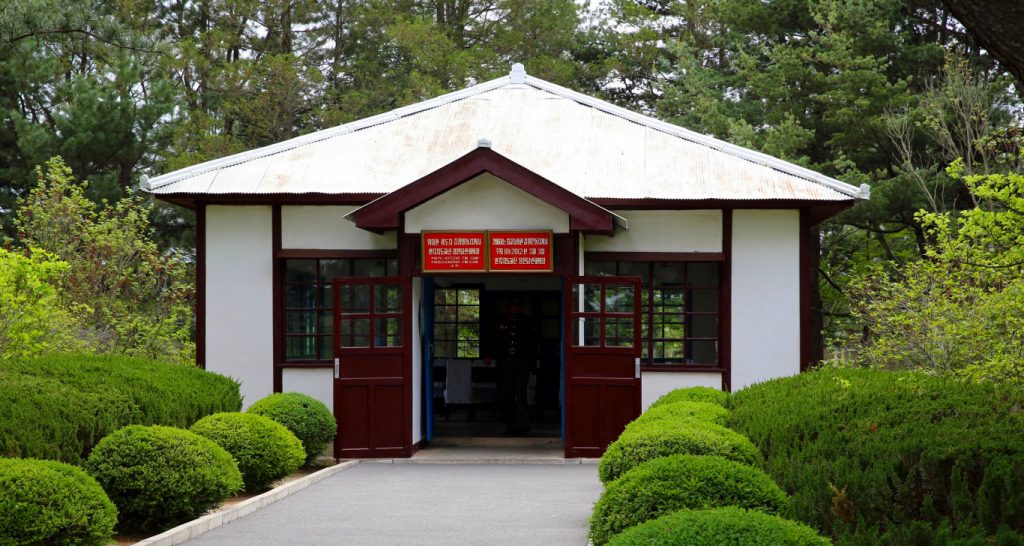
So Ukrainians and their friends are at a crossroads. One road leads to a lengthy continuation of Verdun in some shape or form. The other leads to Panmunjom, where in 1953 American, North Korean, and Chinese commanders were finally able to halt a war that had killed around three million people over the preceding three years. Of those, roughly half a million were fighters on the North Korean/Chinese side; 170,000 were fighters on the South Korean/U.N. side; and an estimated 2-3 million were civilians, many of them killed in massive US bombing raids.
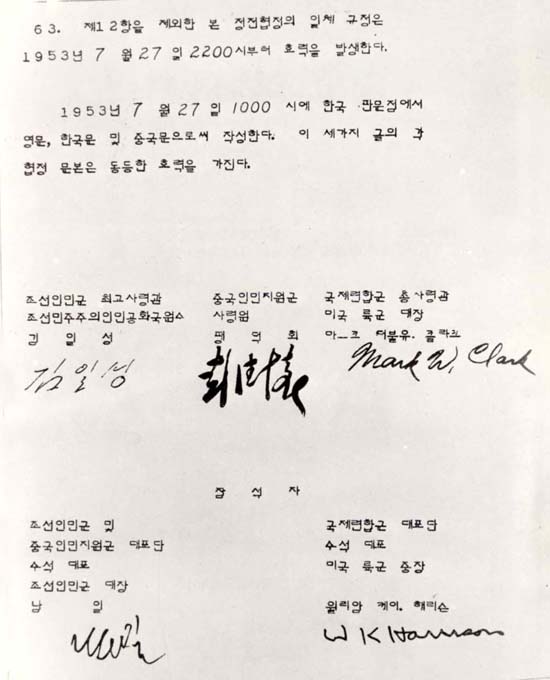

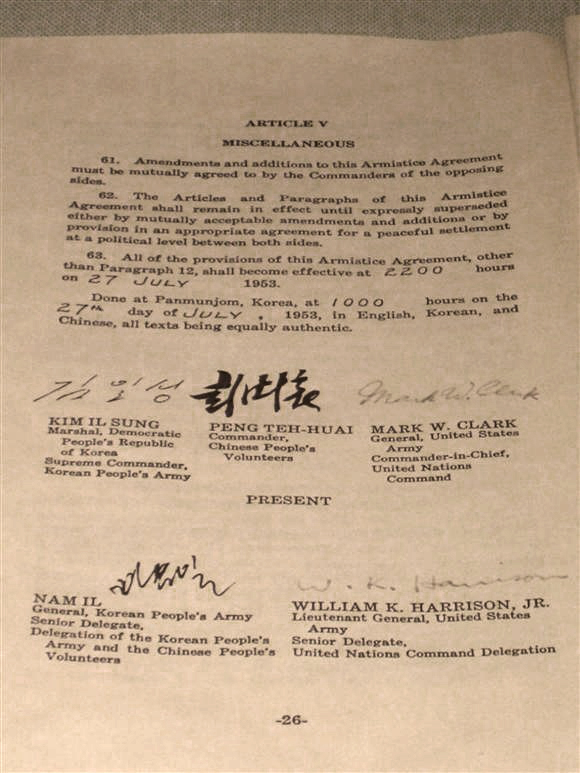
The Panmunjon Agreement was painstakingly negotiated over the course of two years, and was signed in three agreed versions: English, Korean, and Chinese, (see above.) It never led to the planned final peace agreement. Since 1953, there have been periodic outbreaks of tension, threats, and some fighting between North and South Korea. The peninsula has remained highly militarized, and North Korea has declared its withdrawal from the agreement a number of times, most recently in 2013.
But still, the armistice of 1953 halted the “big” war in Korea, and there has not been a big war there since then. Meantime, the armistice allowed for the reconstruction of war-shattered cities and infrastructure throughout the peninsula. In the case of South Korea, the decades after 1953 saw the development of a super-robust economy and a flourishing, increasingly democratic society.
Recently, Russia Today ran a slightly elliptical report indicating that Russia is actively considering a Korea-style armistice in Ukraine. In late November, the Moscow-located writer John Helmer gave more details about plans that he said members of the Russian General Staff were eyeing, for an armistice in Ukraine involving a Demilitarized Zone that would extend deep inside Ukraine…
But the fact that plans for a Korea-style armistice for Ukraine may be favored by the leaders in Moscow should not prejudice the rest of us against such plans. And of course, all the terms of any armistice in Ukraine, including the location of any lines or DMZ’s involved, would be subject to negotiation.
In Korea, those negotiations lasted, as I noted, two years. And the line of separation the parties eventually agreed on was almost exactly the same line that Washington and Moscow had agreed between their respective zones of influence in the country, back before the fighting had even started!
It’s also relevant to note here that the Korean Armistice of 1953 has never been formally agreed to, then or since, by the Government of South Korea. In practice, though, Seoul—which has always been heavily reliant on heavy U.S. military support— has not worked actively to violate the armistice. And some South Korean governments, like that of former Pres. Moon Jae-in, have shown great readiness to reach out to North Korea’s president, Kim Jong-un, for a degree of reconciliation.
But it is certainly worth underlining, in the Ukrainian context, that the Korean Armistice Agreement offers a clear precedent in which one of the belligerent governments involved did not itself sign the agreement, though its external military backers did.
A formal Armistice Agreement is a particular kind of a ceasefire. In any war, belligerents may negotiate short-term or partial ceasefires for any number of reasons, including the establishment of humanitarian corridors, ceasefires to mark religious holidays, and so on. (Recently, there were calls by many faith leaders worldwide for a “Christmas truce” in Ukraine, and the Russian authorities announced a ceasefire to mark Orthodox Christmas, though it is not clear whether that was ever observed.) But an armistice is a ceasefire that is formally agreed to by the fighting parties and covers the whole of an active battle-front. It also contains clauses that:
- Draw the ceasefire line firmly onto an agreed map, along with any zones of demilitarization or limited militarization either side of it;
- Define the diplomatic path to a full, final peace agreement; and
- Define some limits on military resupply or other activities even outside the agreed zones of no or limited militarization.
As noted above, the Korean Armistice Agreement took two years to negotiate. In West Asia, the four parallel Armistice Agreements that Israel and its Arab-state neighbors signed in 1949, to end the war they’d been fighting since May 1948, were concluded in a matter of weeks. (Two of those agreements, the ones with Lebanon and Syria, remain in force today. The ones with Egypt and Jordan got converted into final peace agreements. But altogether, the Armistices proved very beneficial to Israel. Much less so to Lebanon, Syria, and the Palestinians… )
We cannot know how long it would take to negotiate an armistice in Ukraine. But given the level of punishment the country’s people continue to suffer on a daily basis, the sooner the better.
When war broke out between North and South Korea in 1950, the whole of East Asia was in turmoil, and the U.S. forces that had recently established a large presence in the region were reeling from two massive recent setbacks. The northern end of the Korean peninsula shares a long border with China and a very short one with Russia. In September 1949, the Chinese Communists’ Peoples Liberation Army (PLA) reached Beijing, at the culmination of the decades-long civil war it had fought against the country’s U.S.-backed Kuomintang (Nationalist) forces. (The KMT retreated to Taiwan.)
Also in September 1949, the Soviet Union conducted its first test of a nuclear weapon, shattering the global monopoly the United States had held on nuclear weapons since 1945.
The Soviets had had a recognized role in North Korea since 1945. In the last days of WW-2, their Red Army had joined the Allied fight against Japan, as promised. Then, after Japan surrendered in late August 1945, by agreement with Washington the Soviets were designated the military occupiers of Korea north of the 38th parallel. There, their tasks were to receive the surrenders of the local Japanese forces and arrange for the restoration of local administration. South of the 38th, the U.S. forces were performing the same basic tasks in the immediate post-war years.
In China meantime, the advances the PLA made in 1948 and 1949 sent waves of enthusiasm through all the Communist and pro-Communist forces of East Asia—and that included millions of Koreans both south and north of the 38th parallel. In 1948, South Korea saw widespread protests against U.S.-backed strongman Syngman Rhee, which he suppressed only with difficulty.
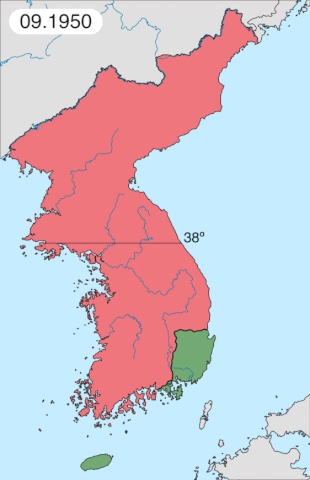
Then, in April 1950, Josef Stalin gave North Korean leader Kim Il-sung the go-ahead to pursue his (Kim’s) longheld dream of reuniting the whole peninsula. In late June, Kim’s armies attacked those of Rhee, linking up with many anti-Rhee dissidents throughout the south. Rhee’s capital, Seoul, fell within two days and his administration collapsed nationwide. By late summer Kim’s forces had taken nearly the whole peninsula.
North Korea’s advance caused as acute a crisis in Washington-Moscow relations as that sparked in Europe in 1948 over Western access to Berlin. But between these two crises, the Soviets had conducted their first test of a nuclear weapon. The crisis over Korea was the world’s first big confrontation between two nuclear-armed powers…
We can look at the Korean War of 1950-53 in terms of the role it played in the interplay of relations among the U.S., the Russians, and the Chinese back in the day—and also, of the role it played in establishing early rules of the road for confrontations between nuclear powers. One thoughtful examination of the war concluded that,
The Korean War… offered not the determinative, but the first, of a series of lessons that would eventually produce full understanding of the paradox of nuclear weapons: They confer upon those who possess them more responsibility for restraint than disposable power.
At a time when the risk of nuclear confrontation hangs over Ukraine and many other parts of the world and when relations among the U.S., the Russians, and Chinese once again define the balance of world affairs, it’s worth going back to examine more closely the lessons from the Korean War—and from the armistice that ended the mass killings there.
A final note here. One key difference between the situation in Korea in the 1950s and the situation in Ukraine today is that, prior to the outbreak of the Korean War, there were already two recognized state-like entities in the Korean peninsula, with an internationally recognized boundary between them. In Ukraine today, there is only one internationally recognized state and Russia’s claims that the populations of Crimea, Luhansk, Donetsk, and Kherson should be allowed to secede have not been widely recognized internationally. NATO, however, which in 1999 energetically and by military means supported Kosovo’s secession from Serbia, and many of whose members supported the secession of South Sudan from Sudan, is not in a great position to object to the principle behind Russia’s claims. ..
What is also clear is that if a future armistice in Ukraine is to have any resilience, it will need to be undergirded by negotiations between Russia and NATO over a range of issues concerning the broader situation in Europe. But let’s take these challenges one step at a time, and start by working for a speedy Armistice Agreement for Ukraine.


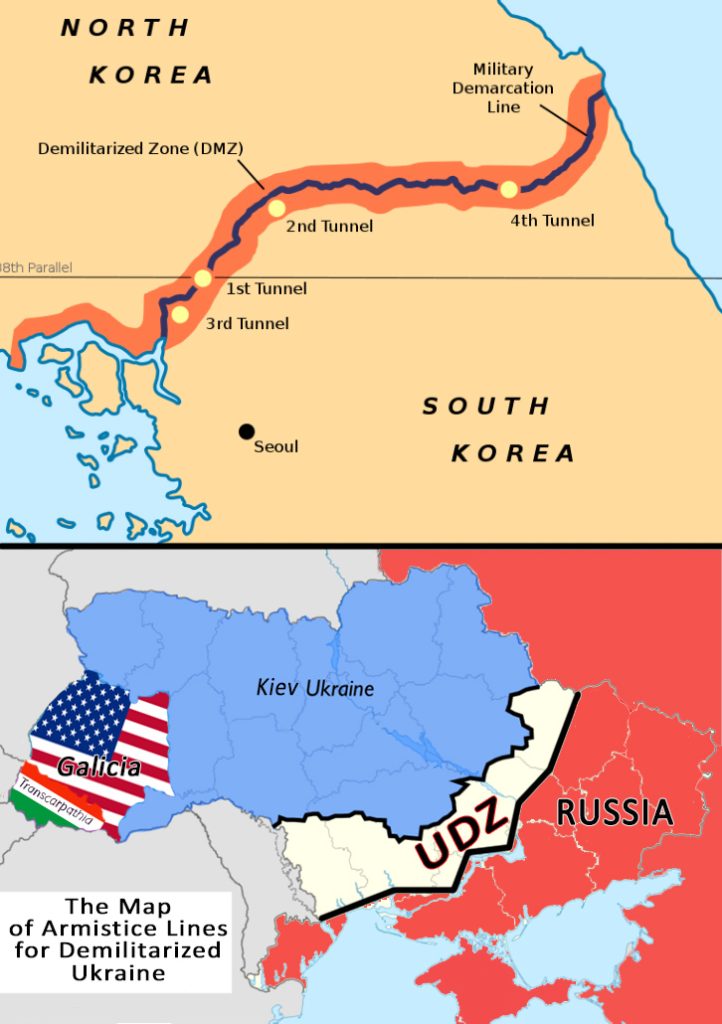


THANK YOU, Helena!
You tell a compelling story here, one I did not know before. It’s fascinating to hear about the ferment of yesteryear that yielded some constructive results. But it’s even more wonderful to see, though your apt telling, the variety of possible parallels between that story and the very-nearly-nuclear story in which we now find ourselves, where the war in Ukraine, if it doesn’t kill us all first, could grind on for years and years– and human lives sacrificed– to come.
Useful info about NATO hypocrisy vis a vis Russia’s support for independence for Crimea, Lukansk, Deonetsk, and Kherson, given NATO’s actions in Serbia and elsewhere. And the statement in parentheses in the first paragraph was important: “(Residents of the country’s eastern provinces have been hammered hard by the Ukrainian military, over the course of several years now. Their fate has been almost ignored in Western media.)” The article would have been better had you given more details and documentation about the hammering by the Ukrainian military of eastern provinces and if you had shortened the historical summary of what happened in Korea.
Right at the end you come to the point which is really at issue. Russia has been refused any chance of its own security being taken into account whenever the “defensive” role of NATO is mentioned. For decades, and especially noted in Pres. Putin’s 2007 speech, NATO has been allowed to designate Russia as an enemy and expand its influence, allow the USA to overthrow the elected government of Ukraine and arm and train anti-Russian militia. The placing of nukes in Poland and Romania is obviously a threat to Russia. The reasonable demands by Russia at the end of 2021 were tossed aside by NATO and the USA with no suggestion that they should be addressed.
There is no valid reason that Russia should be considered a threat at all. It has NOT attacked the West and has tried in vain to be part of it. The “annexation” of Crimea came after the Poroschenko government introduced new restrictions on Russians/language/ rights of Ukrainian Russian speakers ( up to half of Ukrainians) and refused the already- made agreement for the Russian navy to stay at Sebastopol up to 2042. Crimea had a special status and most of the population voted to join Russia. Since Zelenskyy was elected on a promise to come to terms with Russia he has got rid of all opposition parties, all references to Russia and even the orthodox church to which many Ukrainians belong. NATO has supported all the Ukrainian demands, which can only be from some sort of hatred of Russia. The refusal to use the obvious benefits of trade with such an important neighbour has led to terrible economic effects in all of the EU, which is encouraged by leaders who seems to be driven by a sort of unstoppable violence called “sanctions”, quite illegal and also not even effective.
All of this is to say that despite wanting an agreement at any time-please check all the times Russia has asked, and every time the Zelinskyy puppet (you cannot deny he is this) has refused, and the West has dumped vast resources into a destructive war that the Ukrainians insist they can win. Why should Russia want to stop, now that NONE of its needed security has been granted, and now NATO wants to expand more, and Ukraine claims it is already part of NATO. (Uke Defense minister Reznikov today). There has to be some fairness. Russia is certainly NOT the one threatening nuclear war. Lies have been spread in all the western media, and Ukraine’s point of view is the only one ever accepted. Russia has now reached the point where there is no trust, so no agreement is really possible.
Great to hear from you, Rosemerry, and you make some excellent points. I guess my thinking re the likelihood of any speedy achievement of an armistice may be similar to yours– basically, right now, a low probability. But my current aim is to underline for that amorphous thing called “global society” that there *is* a plausible way to negotiate an exit from the hell of Ukraine’s war…
So this would be not just for the publics in NATO countries who are currently drenched in unceasing anti-Russian propaganda but also, probably more importantly, for publics and governments in the Global South, most of whom have been impacted by this war far more severely than anyone in the USA or Western Europe… A speedy armistice followed by broader negotiations over (1) Ukraine and (2) a sustainable security architecture for Europe that is *not* based on hostility, division, and strife: This, surely, is the best way forward. (But oh yes, it would involve the dissolution of NATO as we know it.)